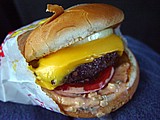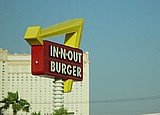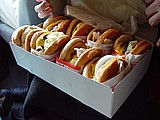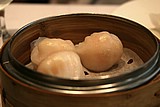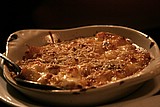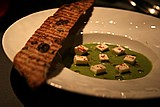Home |
Restaurants by City
|
Food Photography |
Archive | Philosophy |
![]()
Right now we are eating in Seattle, Washington.
|
Tuesday
2004
Permalink
|
And while it's a relief to get that bit of defensiveness off my chest, I do have to admit there are a few reasons why many of our positive experiences are fairly costly. Unsurprisingly, great food usually involves a lot of work. And work costs money. It takes work to find (and create) the best (even if not rarest) ingredients, and the talented people who prepare that food are hard to find as well. It's not as easy to find cheap wonderful food as one might think. Certainly you could make it yourself and that's something we'll be exploring more over time. But when it comes to restaurants, cheap and wonderful often elude discovery. Now you may scoff at this, as you can crawl through stalls of street food in hundreds of cities across the planet and find incredible flavors by the dozens. But, that aside, it's still hard to find restaurants that are inexpensive and wonderful. Not because they don't exist, but because they simply don't get the press. When I go to a new city to try and find its best food, I scour sources far and wide, personal and professional, to get leads on where to eat during my limited time there. And the small, cheap, great places often fly under the radar. Of course, the largest class of (mostly) relatively inexpensive and well known restaurants across the planet are the "chain" restaurants. McDonalds is of course the iconic representation of a chain restaurant but chains cover the gamut. Fast food like Taco Bell and Krispy Kreme are everywhere but there are also "next rung up the ladder" places like Cheesecake Factory and Applebee's. And while many of these are well known everywhere in the U.S., and often almost everywhere on the planet, there are regional chains as well. In the Pacific Northwest there's Pallino Pastaria. There are even "upscale" restaurants like Ruth's Chris steakhouse that's become a surprisingly large chain with around 90 branches in North America and outlets around the world, including one in Taiwan (a location which Ruth's Chris' website calls "exotic"). Can food produced at scale ever be good food? Heitz Cellars, one of the oldest and most respected wineries in Napa Valley, has a variety of wines they offer. Among their most renowned (and most expensive) is their Martha's Vineyard Cabernet Sauvignon. It's a great wine. How many bottles of the Martha's Vineyard did Heitz produce from their 1997 vintage? Keep in mind that 1997 was one of the recent great vintages from Napa Valley and a bottle of Martha's from that year went for roughly $140 a bottle. They produced 67,440 bottles of that wine that they released for sale. This was not an artisanal run of a few hundred cases. They produced this wine by the truckload. Now of course, there's scale, and then there's scale. They can't compare in quantity to the hundreds of thousands of bottles of two-buck chuck and other super-cheap wines that get produced, but still, it's not a small amount. What's the point here? Large-scale is definitely not particularly conducive to making a great food experience. But that doesn't mean it makes it impossible. So today we add a section in our restaurant guide for "chain" restaurants. We'll need to evolve the definition of what makes a restaurant a chain over time. Does the local Thai place with three branches qualify? I don't think so. Does the local pasta place with 8 locations that's adding more every couple of months qualify? I think yes. I admit it's not scientific, but I'll try to get more specific over time. And since we're not going to bring any prejudice to our judgment of "chain" restaurants, whether something's in that category or not doesn't really matter. What matters is whether the food is any good. And that brings us, finally, to today's topic.
Let me take a moment to explain why we made the stop by way of my wife Debbie's love for pizza. She LOVES pizza. And I will admit that I have had pizza in my life that I have loved. But I don't love it unconditionally like she does. I do feel that way about hamburgers. I absolutely adore them. I love the juicy savory meat (medium rare please). I love fresh crisp vegetables. I love cheese on them. I love when they put ketchup and mustard on them, or even thousand island dressing. I don't mind themed burgers with things like mushrooms and onions and barbecue sauce, though I'll admit I draw the line at pineapple. I also don't like soggy bread, or when the hot parts and cold parts have decided to meet somewhere at a mediocre average temperature. I have eaten hamburgers at McDonalds, Burger King, Wendy's, Fatburger and more. I have made hamburgers at home in the oven, in a pan, and on a grill. I have often made hamburgers that resemble the ones described in Eddie Murphy's standup act when he used to be funny. And although he makes fun of them, I love the ones with big chunks of onion and pepper. And in the interest of full hamburger disclosure, I have never had Daniel Boulud's famous $30 burger at DB Bistro (though some close friends have partaken a couple of times and have said it was worth every penny - I will get there eventually). But on this day we were out to eat what is currently my favorite hamburger on the planet, the one made at (as far as I can tell) any In-N-Out Burger with uncanny consistency. One thing I've found in terms of making great food at scale - less is more. Some of the best least expensive food I've ever eaten was from vendors who made only one item. In-N-Out's menu is a monument to simplicity. There's the Hamburger, the Cheeseburger, the Double-Double Burger, French Fries, Chocolate, Vanilla, and Strawberry Shakes, and a variety of sodas. The burgers come with or without onions, with lettuce and tomato, and some "spread" (which seems like thousand island dressing to me). Very simple. But of course, I am a sucker for any marketing gimmick that makes me feel like I'm "in the know" or part of the club. I'm so transparent that even a hamburger chain knows how to appeal to my insecurity about belonging to the group. The "secret" menu (of which they publicize only a portion of on their website - more brilliant marketing) contains items like the 3x3 - three patties, three slices of American cheese (yes there's a 4x4); Animal Style - add mustard, pickles, grilled onions, and extra spread to your burger; Protein Style - burger minus the bun, wrapped in lettuce; and the Neapolitan Shake - a mix of all three shake flavors. And here's the funny thing - their shakes are very good but not mind-blowing, and their fries are honestly mediocre. They make them fresh right in front of you but there's something limp about them that the freshness can't make up for. (You can order them “well done” but that didn’t make a huge difference in my opinion.) McDonald's fries (when they were fried in animal fat) were way way better. And none of that matters. Because their hamburgers are to die for. The fries and shakes were just filler in my opinion. The name of the place isn't In -N-Out Fries or In-N-Out Shakes. It's In-N-Out Burger, and that's what they do well. Very well. The patty itself is thick and relatively small in diameter. It's not a broad flat patty so it's not convenient to store, and doesn't lend itself well to stacking. It's an unwieldy (almost) ball of meat. The bun is freshly baked, and serves its purpose. It's not there to shine. It's there to deliver its contents in a package that doesn't get your fingers completely greasy. The rest of the contents of the sandwich can only be described as slathered over either the meat or the bun. The cheese and spread are generously oozing from your sandwich opening as it sits peeking out of its paper holder. I got mine with fresh onions as I love the bite and the crunch. Biting into this burger fills your mouth with absolute essence of hamburger. It's not fancy. It's basic. It's hamburger distilled into it's most simple and perfect form and then concentrated to pack one monster hamburgian punch. The contrasting temperatures, the mix of textures - all combine to make for a diverse and yet simple experience. And ultimately (at least for me) all the anticipation is rewarded by that first comforting bite. And unlike many fast food chains (or chain restaurants that optimize around speed) there's no sick feeling after I'm done eating.
I live in Seattle and don't get to eat at In-N-Out very often, but when I lived in Northern California I remember being willing to eat lunch at 2pm to avoid the seemingly endless lines that snaked out of the local branch. Don't think that at 2pm the lines were not there, just more tolerable. I'll admit it's rare to find a large-scale chain that serves something so delicious, but like I said - I don't care whether it's cheap or expensive, I don't care what business model they employ, and I don't care whether they have a national ad campaign, or a hand- painted sign over a wooden table. I just love food that tastes great. And In-N-Out Burger's hamburgers fit squarely in that category.
|
|
Our Sponsors
Online Loans – Conversion Strategies – College Courses – Surprise Birthdays – Online Trading - Calendar and Event Schedules - Food Events and Calendars - Wine Events and Calendars - Digital Photography Resources - Jewish Gifts and Judaica - Howard Stern Podcast ponytailed blogger Jonathan Schwartz

Browse tastingmenu
Home |
Restaurants by City X |
Food Photography |
Archive | Philosophy |
![]()
Free eBooks: All About Apples
| Autumn Omakase
More:
Discussion |
Cool Food T-Shirts |
Ingredients
| Markets |
Recipes
Search |
Blog FAQ |
Other
Blogs
Best of tastingmenu
|
City View
Entry: July 6, 2006 |
Blue Plate
Entry: June 19, 2006 |
L'Atelier de Joël Robuchon
Entry: July 18, 2006 |
Browse by City
Boston | Chicago | Houston | Las Vegas | Los Angeles | Maui | New York | Philadelphia | Portland | San Francisco | Seattle | Toronto | Utah | Vancouver | Washington D.C.
Bangkok | Beijing | Hong Kong | Seoul | Tokyo
Amsterdam | Berlin | Italy | London | Madrid | Paris | Vienna
Browse by Month
2006
2005
2004
2003
2002
2001
Comments, questions, or feedback:
info / at / tastingmenu / dot / com
All pages Copyright (c) 2001-2006 tastingmenu.com
Last modified 11/27/06.
